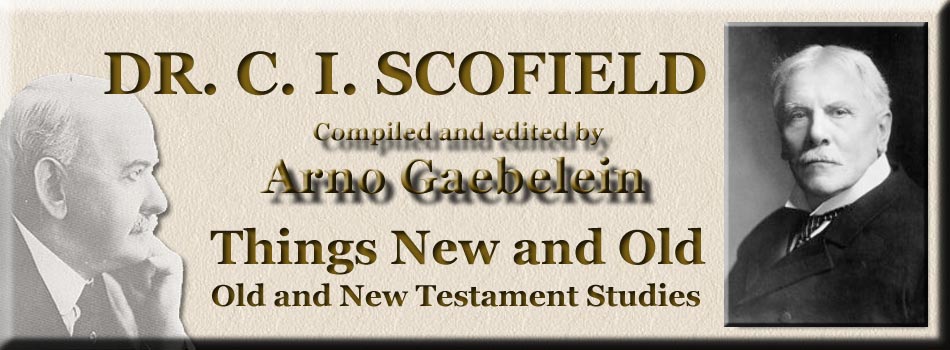
Things New and Old
By Cyrus Ingerson Scofield
Compiled and Edited By Arno Clement Gaebelein
THE FIRST MIRACLE IN CANA.(John ii:i-ii.) I. The Analysis. 1. The Social Christ (verses i, 2).—With a world's salvation for His mission, and with but little more than three years for testimony, our blessed Lord could find time, and think it worth while, to share and increase the innocent social joy of a wedding. A lesson, surely, to those who think such things "wordly." The definition of ''the world" in the bad sense in which that term is used in Scripture needs enlarging in the minds of many truly earnest, but narrow minded Christians. The "world" in the bad sense is that kingdom of Satan here in the earth, the badge of which is ostentation, or the desire for things not for the ministry there may be in them to man's manifold being, but for mere display, pride, and conspicuity; and the rewards of which are present wealth, power, or position. At the heart of it lies self-exaltation. Of that world no follower of the Lord Jesus should ever be a part. But to condemn eating and drinking as part of a large and beautiful social life, and to reprobate surrounding such occasions as weddings, birthdays, anniversaries and the like with joyous companionship, is to be holier than Christ, and to go back to John the Baptist. 2. The Manifestation of His Glory (verses 3-11).—See "Heart." II. The Heart of the Lesson, The heart of this lesson is plainly indicated in verse 11. The "sign" was a manifestation of "His glory." Perhaps there is no more difficult word in Scripture than the word "glory." And, as in the case of the word "world," the difficulty arises from the diverse uses of the word. Sometimes it means outward splendor, merely, as, "The kingdoms of this world and the glory of them" (Luke iv:6). Sometimes the word is used of that superhuman radiance which announces the immediate presence of Deity (Ex. xvi:10; I Kings viii:ii). Sometimes the word is used of the people's praises of God (Matt. xv:21). But always the fundamental idea is the manifestation of Deity in some or all of His excellences. We, for example, glorify God when we make known in life or testimony "the excellences of Him who hath called us out of darkness into His marvellous light." With this explanation we are prepared to see how, in making the water wine Christ "manifested His glory." It was a creative act, and creative power belongs to God alone. The "sign," however, had a purpose beyond the demonstration of the fact that in Jesus of Nazareth God was Himself among men. In the structure of John's Gospel the announcement of a new truth is commonly accompanied by an illustrative miracle. In John viii:12, for example, our Lord says, "I am the light of the world." In the succeeding chapter He performed the illustrative miracle of giving sight to a man born blind. So here He prefaces the great teaching on the new birth by turning water into wine. The "sign" at the wedding feast, therefore, represents Him as the Author of the new creation (1 Cor. xv:45-49). Still another "glory" of our Lord was manifested at the wedding feast. Here, at the outset of His great work, He revealed Himself as the social Christ. It is the characteristic of the new dispensation that all innocent human joy is sanctified in Christ. John the Baptist, the last of the Old Testament prophets and saints, was an ascetic. He came neither eating nor drinking. Christ as He said of Himself, came eating and drinking. He was constantly found in human habitations. He sought the family. Puritanism has woefully hidden the social Christ.
|
|
 |
 |
|
|
|
-
Site Navigation
 Home
Home What's New
What's New Bible
Bible Photos
Photos Hiking
Hiking E-Books
E-Books Genealogy
Genealogy Profile
Free Plug-ins You May Need
Profile
Free Plug-ins You May Need
 Get Java
Get Java.png) Get Flash
Get Flash Get 7-Zip
Get 7-Zip Get Acrobat Reader
Get Acrobat Reader Get TheWORD
Get TheWORD